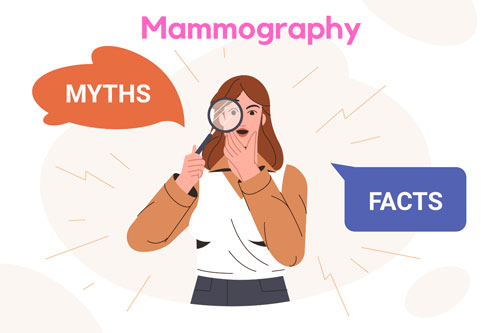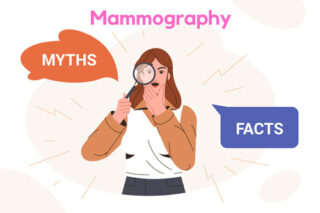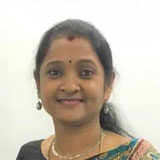7 Myths of Mammography & Why You Should Never Believe Them!

7 Myths of Mammography & Why You Should Never Believe Them!
Dr. M. Jwala Srikala, Consultant Radiologist,
India’s Leading Mammography Expert
 In India, although mammography awareness is rapidly rising, myths too are many.
In India, although mammography awareness is rapidly rising, myths too are many.
Myths instill fear, and may force you to avoid regular screening that can be the difference between life and death.
No one can prevent breast cancer. Early detection is the best protection. Simply knowing the facts about mammograms may save your life or the life of someone you love!
Seven key mammography myths that we often encounter are busted below. Read on to see what you already knew and what you can learn:
Myth # 1: I don’t need a mammogram unless I feel a lump.
Fact: By the time you can feel a lump, the cancer has already spread.
It takes two to five years of growth[1] for the breast cancer to be felt even by trained hands of a doctor. By then, it is already at least 2 cms in size and has probably spread to the armpit.
Whereas mammograms can detect breast cancer very early. Hence whether you have any symptoms or not, yearly mammography is recommended by Breast Imaging Society of India (BISI)[2], American College of Radiology (ACR)[3], and several other global authorities, if you are eligible by age (40 years) or additional risks (earlier).
Myth # 2: I don’t have a family history of breast cancer. So, I don’t need screening.
Fact: Only 5%-10% of breast cancer cases are associated with a family history[4].
Vast majority of breast cancers occur due to unknown causes and factors such as environment, lifestyle, obesity, etc. Hence, even if you have no family history of breast or any other cancer, please do subscribe to an annual mammography schedule, once you are 40 years old. For women with family history or any other additional risk, the doctors may recommend it from a younger age.
Myth # 3: My last year’s mammogram was normal. So, I don’t need it again this year.
Fact: Mammograms do not provide immunity against breast cancer.
The past mammograms neither predict nor assure that you will be cancer-free in future. Also, interval cancers, meaning cancers occurring between two serial annual screening mammograms, can suddenly emerge. Hence the medical experts recommend prompt annual mammograms so that cancers can be detected when they are very small in size and very much confined to the breast alone.
Myth # 4: I can choose either Mammogram, Ultrasound, MRI, or Self-breast-exam for regular screening. They are all the same.
Fact: Mammography remains the gold standard[5] for early detection of breast cancer– as concluded by a University of California headed expert panel that reviewed 18 different detection systems.
Most medical organizations do not recommend self-breast-examination[6] because it does not help early detection. Ultrasound is more of a diagnostic tool than a screening tool, and sometimes an add-on to mammography. It is most often used to further assess palpable and non-palpable masses detected by the screening mammography[7]. The high cost of MRI – approximately 10 times the cost of mammography and its lower specificity i.e., ability to correctly differentiate cancer from non -cancer lumps compared to mammography, prohibits its routine use for screening general population[8]. However, for screening high-risk young women, MRI may be sometimes used.
Myth # 5: Mammograms are painful.
Fact: Getting a mammography done today is different than in the olden times.
The newer, ergonomically designed compression pads minimize discomfort, and some latest 3D mammography machines take just 3.7 seconds to scan that minimizes the compression time significantly. Also, a study[9] points out that your memories of your last mammography experience are a good predictor of your next one. Hence try not to be anxious before your next mammography, and you may feel alright.
Further Reading: Is Mammography Painful? An illuminating blog on our website.
Myth # 6: Mammograms expose me to harmful radiation, which may cause cancer.
Fact: Mammograms use very low-dose radiation within the strict guidelines approved by the medical and regulatory authorities.
Some of the latest 3D mammography machines expose you to even lower radiation than these statutory doses. Also, the mammography radiation is equal to about two months of atmospheric radiation that we all are exposed to every day. The benefits of screening mammogram far outweigh the risk of this small exposure to radiation.
Further Reading: Is Mammography Radiation Harmful? A very educative blog on our website.
Myth # 7: Mammograms are costly.
Fact: Mammograms are not costly.
Just like a car insurance you buy every year with a small premium to protect yourself against a potentially large expense due to an accident that may never occur, spending a small amount on mammography every year may help you save 30% to over 100% of the treatment costs of breast cancer compared to the women who present with advanced stage breast cancers[10].
Early detection may also qualify you for less invasive treatment options. For example, in early breast cancers, chemotherapy may be completely avoided thereby saving you the costs incurred and its side effects.
Most importantly, a small yearly investment in screening mammography may save immense stress to your loved ones which is a priceless benefit if you agree.
Further Reading: Is Spending Every Year on Mammography Justified? A popular blog on our website.
So, what can you do today?
Screening mammography performed annually on all women beginning at age 40 years has reduced breast cancer deaths by 30% to 50%[11] because early diagnosis of breast cancer dramatically improves the chances of complete cure, and disease-free survival with 93% or higher survival rates in the first five years[12].
If you are eligible for breast screening either by age (40 years and above), or due to high-risk factors such as family history (in which case even if you are younger than 40 years), subscribe to an Annual Screening Mammography plan today – A simple ritual that can save your life!

Dr. M. Jwala Srikala, Consultant Radiologist,
KIMS Hospitals, Hyderabad
- https://oregon.providence.org/forms-and-information/a/ask-an-expert-breast-cancer-growth-rate/
- https://www.bisi.co.in/guidelines/mammography/
- https://www.acraccreditation.org/Mammography-Saves-Lives/Guidelines
- Liu, L., Hao, X., Song, Z. et al. Correlation between family history and characteristics of breast cancer. Sci Rep 11, 6360 (2021). https://doi.org/10.1038/s41598-021-85899-8
- https://www.webmd.com/breast-cancer/features/mammography-still-gold-standard-for-breast-cancer
- https://www.mayoclinic.org/tests-procedures/breast-exam/about/pac-20393237
- Gordon PB. Ultrasound for breast cancer screening and staging. Radiol Clin N Am. 2002;40:431-44112117185 https://www.radiologic.theclinics.com/article/S0033-8389(01)00014-8/fulltext
- Elmore JG, Armstrong K, Lehman CD, Fletcher SW. Screening for Breast Cancer. JAMA. 2005;293(10):1245–1256. doi:10.1001/jama.293.10.1245 https://jamanetwork.com/journals/jama/fullarticle/200479
- Kornguth, Phyllis J.a,*; Keefe, Francis J.b; Conaway, Mark R.c Pain during mammography: characteristics and relationship to demographic and medical variables, Pain: August 1996 – Volume 66 – Issue 2 – p 187-194 https://www.sciencedirect.com/science/article/abs/pii/0304395996030576
- Feig S. Comparison of costs and benefits of breast cancer screening with mammography, ultrasonography, and MRI. Obstet Gynecol Clin North Am. 2011 Mar;38(1):179-96, ix. doi: 10.1016/j.ogc.2011.02.009. PMID: 21419333. https://pubmed.ncbi.nlm.nih.gov/21419333/
- Feig S. Comparison of costs and benefits of breast cancer screening with mammography, ultrasonography, and MRI. Obstet Gynecol Clin North Am. 2011 Mar;38(1):179-96, ix. doi: 10.1016/j.ogc.2011.02.009. PMID: 21419333. https://pubmed.ncbi.nlm.nih.gov/21419333/
- https://www.carolmilgardbreastcenter.org/early-detection
